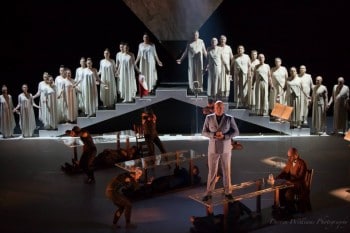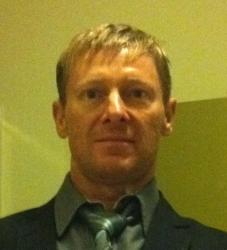State Opera of SA: Akhnaten
Though in compositional chronology it’s the last in the Philip Glass Portrait Trilogy of operas, Akhnaten begins the current State Opera of South Australia’s world-first presentation of all three as part of a three-cycle event. Followed by Einstein on the Beach and Satyagraha, the trilogy follows the order of earlier smaller productions staged between 2002 and 2007. The result is a project teaming with love and pride, supported by a 20-year collaboration between director and choreographer Leigh Warren and artistic director, CEO and conductor of the trilogy, Timothy Sexton.

Akhnaten cajoles the senses while elevating mankind’s spirit of determination. The eponymous Egyptian pharaoh who overturned polytheism in favour of the worship of the sun god Aten, Akhnaten’s religious reform is considered by many to be the beginning of monotheism. Mystery surrounds the reasons for his religious changes as well as much of his life. Add any hint of Ancient Egypt, combine that with the hypnotic charm of Philip Glass’ cyclical music in a production that daringly resets the story in modern times (despite appearing pseudo-ancient), and it really isn’t surprising that you leave the theatre carrying a mystery with you.
Warren adjusts the usual three-act opera, which Glass premiered in Stuttgart in 1984, as a two-part piece, maintaining the same scene sequence and inserting one interval, and it works marvellously. Warren says of his interpretation, “My Akhnaten is not set in Egypt but rather the royal family is represented through a foundation that preserves the memory of the past and in this case the memory of Akhnaten and Nefertiti”. In a production heavily overlaid with dance resembling both hieroglyphics in motion and a conglomeration of changing masses, the Leigh Warren Dancers both cut space and build forms across the stage with precision and beauty. Dance extends to the cast of soloists and the chorus, pervading the performance to such an extent that you’d believe Glass intended it to be ballet. There are times when the eye cannot rest with the music and voices as dance tangles the story-telling, but on the whole and despite the overkill, the connection is legible.
Sexton dispenses a warm, eloquently controlled musical world and guides the musicians of the Adelaide Art Orchestra and his audience on a fruitful journey. In the unflattering, hardly magisterial interior of Adelaide’s Her Majesty’s Theatre, Glass’ music captivates with rhythmic viscosity. A brief silence follows each scene with an uncomfortable emptiness where time feels distorted and an eagerness to return to the music’s hypnotic beauty is felt. In the opening prelude and occasionally scattered throughout, there are some blurry brass edges that sadly fray the acoustic fabric. There is also certainly room for a more expansive sound, especially in “The Coronation of Akhnaten” and “Attack and fall”, but the overall handling is creditable and ripe.
It is the warm, quavering countertenor voice of Tobias Cole, soaring with projectile force as Akhnaten, which brings us back to opera. Together with the lucent, sweet voice of Cherie Boogaart as Akhnaten’s wife, Nefertiti, the pair work visual, vocal and dance magic, finding its pinnacle in the Part 1 love duet, “Akhnaten and Nefertiti”, first in a sensual exploration, then in trusting love. Deborah Caddy as Akhnaten’s mother, Queen Tye, exhibits all-round cultivated authority and as a formidable family vocal trio, the effect is impressive.
Religiously opposed to the royal family, but with equal command in performance, a trio of brute strength is formed by Adam Goodburn as High Priest Amon (also Scribe and tour guide), Andrew Turner as Horemhab, and Robert England as Aye. A chorus of priests and people of Egypt enacted by the State Opera Chorus complete the vocal picture with flair.
Set and costume designer Mary Moore’s simple, white, sheath-dressed chorus of ancient Egyptians contrasts neatly with the slick costumes of corporate success. Unfortunately, a one-set-fits-all design approach, in itself nothing to argue over, lacks inspiration and depth. Consisting of little more than a shallow, symmetrically stepped platform, three large table-tops, and an inverted pyramid hanging centrally as a backdrop, I just couldn’t see some solid homework done since her designs for the smaller 2002 production. During Part 1’s “The temple”, as Akhnaten attacks the temple, the pyramid splits to reveal an infinitely receding solar panel. No longer a symbol, a solar panel actually harnesses the energy of the sun, and hence the sun god. I didn’t buy it. Similarly for Geoff Cobham’s satisfactory but unexciting lighting, the offering is unbefitting the creativity and talent invested elsewhere.
In a poetic and pensive ending, the ankh (looped cross), symbol of immortality, is carried ceremoniously centre stage. Though defeated, Akhnaten, Nefertiti and Queen Tye, under their “sarcophagi” tables with arms folded in repose, make that journey to immortality. It’s one of many glorious moments where music, voice, stage and breathtaking dance align with meaty synergy. In upholding Glass’ groundwork, however, it was hoped that synergy might be felt with greater continuity.
Also known as ‘OperaChaser’, Paul’s passion for attending opera in performance spans 30 years. With a background in architecture and an unstoppable need to travel, Paul’s foray into the world of reviewing started as Opera Australia’s inaugural Critic-in-Training. He has reviewed opera for various other websites and currently blogs at operachaser.blogspot.com.au.
Follow @OperaChaser on twitter

